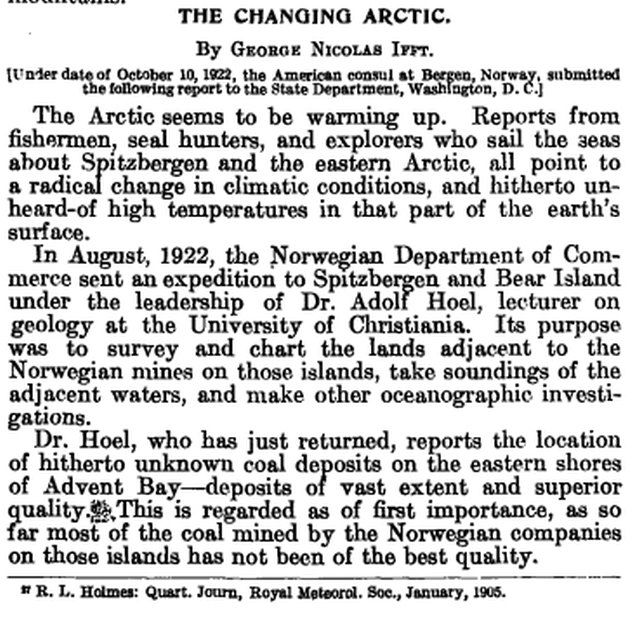"The Arctic seems to be warming up. Reports from fisherman, seal hunters, and explorers who sail the seas about Spitzbergen and the eastern Arctic, all point to a radical change in climatic conditions, and hitherto underheard-of high temperatures in that part of the earth’s surface.
In August, 1922, the Norwegian Department of Commerce sent an expedition to Spitzbergen and Bear Island under the leadership of Dr. Adolf Hoel, lecturer on geology at the University of Christiania. Its purpose was to survey and chart the lands adjacent to the Norwegian mines on those islands, take soundings of the adjacent waters, and make other oceanographic investigations.
Ice conditions were exceptional. In fact, so little ice has never before been noted. The expedition all but established a record, sailing as far north as 81° 29′ in ice-free water. This is the farthest north ever reached with modern oceanographic apparatus.
The character of the waters of the great polar basic has heretofore been practically unknown. Dr. Hoel reports that he made a section of the Gulf Stream at 81° north latitude and took soundings to a depth of 3,100 meters. These show the Gulf Stream very warm, and it could be traced as a surface current till beyond the 81st parallel. The warmth of the waters makes it probable that the favorable ice conditions will continue for some time.
In connection with Dr. Hoel’s report, it is of interest to note the unusually warm summer in Arctic Norway and the observations of Capt. Martin Ingebrigsten, who has sailed the eastern Arctic for 54 years past. He says that he first noted warmer conditions in 1918, that since that time it has steadily gotten warmer, and that to-day the Arctic of that region is not recognizable as the same region of 1868 to 1917.
Many old landmarks are so changed as to be unrecognizable. Where formerly great masses of ice were found, there are now often moraines, accumulations of earth and stones. At many points where glaciers formerly extended far into the sea they have entirely disappeared."

and:

Is there global warming? I guess there is. Around 0.6 degrees Centigrades since 1950.
Last summer, I was in the Austrian Alps, more precisely the Hohe Tauern, where I climbed Grossglockner with two buddies. We started out from the Glocknerhaus, a relatively Spartan hotel near the Margaritzespeicher. Up the valley we could see what remained of the Pasterze Glacier below Grossglockner. There is indeed not much left.
However... behind the hotel there's a photo display consisting of some 5 or 6 billboard-like info panels with photos dating back to the 1860s or so.
On these displays you could clearly see that before the end of the 19th century, the retreat of the Pasterze Glacier had already begun... although the CO2 output of the world's industries was but a tiny fraction - perhaps as little as 2% - of what it is now. Make it 2%, for the sake of the argument.
Am I to believe that the Alpine glaciers started retreating because of 2 per cent of today's CO2 output?
I won't.
MFBB.
No comments:
Post a Comment